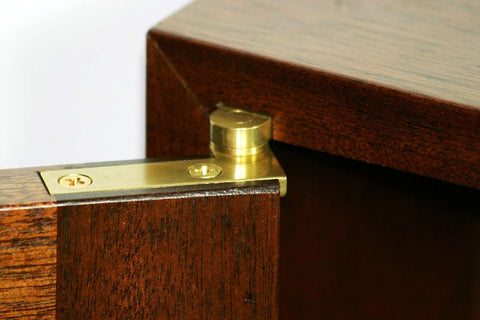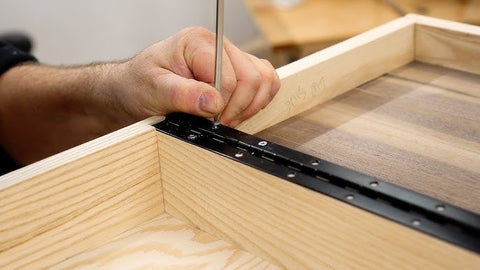
Learn About 8 Kinds of Cabinet Door Hinges
When it comes to cabinet doors, the hinges may not be the first thing on your mind, but they play a crucial role in how your cabinets function and look. Choosing the right type of hinge can make a significant difference in the overall aesthetics and usability of your cabinets. In this article, we'll delve into eight different types of cabinet door hinges, explaining each one in simple terms, so you can make an informed decision for your home.
Butt Hinges

Butt hinges are a traditional and straightforward type of hinge used for various applications, including cabinet doors. They consist of two rectangular metal plates, with one plate attached to the cabinet door and the other plate fastened to the cabinet frame. These two plates are joined together, allowing the cabinet door to swing open and closed.
One of the key advantages of butt hinges is their durability. They are designed to withstand the test of time, making them a reliable choice for cabinet doors that see frequent use. These hinges are known for their stability, which means that when you open or close the cabinet door, it's less likely to wobble or sag. This stability is essential, as it ensures that your cabinet doors remain aligned and function smoothly.
Butt hinges are commonly used for both interior and exterior doors in addition to cabinet doors. They can be found in a variety of sizes, finishes, and materials, allowing you to choose the ones that match your cabinet's design and your personal preferences. These hinges are also relatively easy to install, making them a practical choice for DIY enthusiasts.
When selecting butt hinges for your cabinet doors, it's essential to consider the door's weight and size. Larger and heavier doors may require larger and sturdier butt hinges to ensure they function correctly and do not sag over time. It's also worth noting that these hinges are typically visible when the cabinet door is closed, so their appearance can affect the overall aesthetics of your cabinets.
European Hinges

European hinges, also known as concealed hinges or cup hinges, are a popular choice for modern cabinet doors. They are called "European" hinges because they originated in Europe and have become widely used for their sleek and unobtrusive design.
These hinges are known for their discreet appearance when the cabinet door is closed. Unlike butt hinges, which are visible when the door is shut, European hinges are concealed within the cabinet structure. This gives your cabinets a clean and contemporary look, with no visible hardware on the exterior.
One of the significant advantages of European hinges is their adjustability. Most European hinges have built-in adjustment mechanisms, allowing you to fine-tune the alignment of your cabinet doors. This is especially useful when you want all your cabinet doors to be perfectly level and uniform. The adjustability feature makes it easier to achieve a polished and professional look.
European hinges come in various types, such as full overlay, half overlay, and inset hinges. The type you choose depends on your cabinet design and personal preferences. Full overlay hinges are used for doors that completely cover the cabinet frame, giving a seamless and modern appearance. Half overlay hinges are suitable for doors that partially overlap the cabinet frame, while inset hinges are used when you want the door to be flush with the cabinet frame.
Installation of European hinges might require some precision, but it's not overly complex. You'll need to create a shallow hole or "cup" in the door where the hinge will be attached. The other part of the hinge, known as the mounting plate, is attached to the cabinet frame. When the door is closed, the hinge components fit together neatly within the cup, keeping them hidden from view.
Overlay Hinges
Overlay hinges, also known as overlay cabinet hinges, are a type of hinge commonly used for cabinet doors that have a partial or full overlay design. These hinges are an essential component when it comes to ensuring the smooth operation of cabinet doors, and they also play a role in determining the overall aesthetics of your cabinets.
Overlay hinges are named after the overlay of the cabinet door in relation to the cabinet frame. The overlay refers to how much the door "overlaps" the frame when the door is closed. There are generally two types of overlay hinges:
Full Overlay Hinges: With full overlay hinges, the cabinet door completely covers the cabinet frame, leaving only a small gap between adjacent doors. This design creates a seamless and modern appearance, making it a popular choice for contemporary kitchen and bathroom cabinets.
Half Overlay Hinges: In the case of half overlay hinges, the cabinet door partially overlaps the cabinet frame. This results in a more traditional and classic look. Half overlay hinges are often used in cabinetry that has a more traditional or transitional style.
Inset Hinges
Inset hinges, also known as inset cabinet hinges, are a type of hinge designed to create a flush and seamless appearance when the cabinet door is closed. They are often used in traditional and classic cabinet designs, providing a timeless and elegant look.
The distinguishing feature of inset hinges is that they are installed in a way that allows the cabinet door to sit flush with the cabinet frame when closed. This means that when the door is shut, it is level with the surrounding cabinet structure, creating a smooth and refined finish. This is in contrast to overlay hinges, where the door partially or fully covers the cabinet frame when closed.
Installing inset hinges requires precision, as they need to be precisely recessed or "inset" into both the door and the cabinet frame. This precision ensures that the door fits precisely and doesn't protrude or create an uneven surface when closed. While the installation may be more involved compared to other hinge types, the result is well worth the effort, as it provides a high-end and sophisticated appearance.
Inset hinges come in various styles, including butt hinges, European-style hinges, and knife hinges, each offering its unique advantages and aesthetics. Some inset hinges have built-in mechanisms that allow for easy adjustment, making it simpler to fine-tune the door's alignment for a perfect fit.
These hinges are commonly used in cabinetry where aesthetics and craftsmanship are highly valued, such as in kitchens, bathrooms, or fine furniture pieces. Inset hinges can be particularly appealing for homeowners who appreciate the clean and classic look they bring to their living spaces.
When selecting inset hinges, consider factors such as the door weight, door size, and the cabinet design. Ensuring that the hinges are of the right size and quality is essential for achieving the desired flush and professional appearance. Additionally, if you want your cabinets to exude a timeless charm, inset hinges may be the perfect choice for your cabinetry needs.
In conclusion, inset hinges are an excellent option for those who seek a classic and refined appearance for their cabinet doors. Their ability to create a flush and seamless look when doors are closed makes them a preferred choice for traditional and elegant cabinet designs. When properly installed and well-matched to your cabinet's design, inset hinges can elevate the overall aesthetics of your living spaces.
Pivot Hinges

Pivot hinges, also known as center-mount hinges, offer a unique and eye-catching alternative to traditional cabinet door hinges. These hinges function by allowing the cabinet door to pivot from a central point on the door itself, rather than swinging on the side like conventional hinges. This design provides a distinctive and artistic touch to your cabinetry.
The central pivot point of these hinges can create a mesmerizing effect when the door is opened or closed. Instead of the door swinging to the side, it rotates on its central axis. This can be especially intriguing when used for cabinet doors with a distinct or artistic look, as it showcases the door's design in a visually engaging way.
Pivot hinges can be installed in various configurations. They can be placed at the top and bottom of the door, or sometimes even just at the top, depending on the desired effect. The central pivot point can create an elegant and minimalist appearance for your cabinets, making them ideal for modern and contemporary designs.
Continuous Hinges

Continuous hinges, often referred to as piano hinges, are a type of hinge that runs the entire length of a door or lid. These hinges are known for their long, slender appearance and are primarily used for applications requiring additional strength and support. They are commonly found on heavy cabinet doors, toolboxes, pianos, and other items that need reliable and robust hinge mechanisms.
The key feature of continuous hinges is their continuous design, which means that they extend along the entire edge of the door or lid. This extended length distributes the weight and stress evenly, making them an ideal choice for heavy or long doors. Continuous hinges are typically made from durable materials like steel or stainless steel, ensuring they can withstand frequent use and substantial loads.
Barrel Hinges

Barrel hinges, sometimes called cylindrical hinges, are a type of hinge with a unique and distinctive appearance. These hinges are often used for both functional and decorative purposes, and they can add a touch of uniqueness to your cabinet doors or other applications.
Barrel hinges consist of a cylindrical barrel-shaped hinge that fits into a hole drilled into the door and the cabinet frame. When installed, the barrel rotates to allow the door to open and close. The visual effect of the cylindrical shape can create an interesting and eye-catching detail on your cabinet doors.
Self-Closing Hinges
Self-closing hinges, as the name suggests, are a type of cabinet hinge equipped with a built-in mechanism that ensures the cabinet door automatically closes when it's let go. These hinges are commonly used in various applications, such as kitchen cabinets, bathroom vanities, and even closet doors, where the convenience of doors that close on their own is valued.
The mechanism within self-closing hinges typically consists of a spring or tension system. When the door is pushed or pulled open, the spring inside the hinge is compressed, storing energy. As the door is released, the spring's energy is released, causing the door to swing shut gently and securely. This feature is particularly useful in busy areas of the home, as it prevents cabinet doors from accidentally remaining open, promoting safety and maintaining an organized appearance.
Self-closing hinges come in various types, including overlay and inset varieties, and they can be installed on both face-frame and frameless cabinets. These hinges are available in different styles and finishes, allowing you to match them to your cabinet design and personal taste.
In conclusion, the type of cabinet door hinge you choose can have a significant impact on the functionality and appearance of your cabinets. By understanding these eight different hinge types and their characteristics, you can make an informed decision that suits your preferences and needs. Whether you opt for the durability of butt hinges, the sleekness of European hinges, or the unique look of barrel hinges, your cabinets will benefit from the right choice. So, take your time, consider your cabinet design, and select the hinges that will best complement your home's style and functionality.



